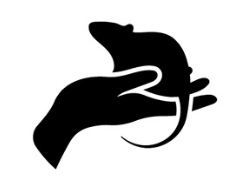New COVID Strains Can Transfer from Humans to Rats
What to know so we don’t pass it on to our rats
Yup, you read that right.
While rats couldn’t initially contract the SARS-CoV-2 virus easily, some newer strains such as Omicron have evolved to infect a larger range of hosts. Studies have shown human-to-animal transmission in several domestic species, including cats, hamsters, rabbits and now, rats.
Scientists have investigated the case of a rat owner living just outside of Paris, France in May of 2022 who tested positive for the Omicron strain of SARS-CoV-2 after becoming ill.
Recovering from any illness can be an isolating and exhausting process, so who wouldn’t want to find comfort in their furry friends? During their eight days of active symptoms, the owner was in close contact with their pet rats for cuddles. They had two males, one being three years old and the other six months.
Unfortunately, four days after the owner’s symptoms had resolved, their three year old male rat fell very ill, showing many of the more extreme signs of respiratory infection. He was lethargic and not eating, and was in respiratory distress, with open-mouthed breathing, excessive porphyrin, and the blue tinge of cyanosis in the feet, tail, ears and gums that indicates a lack of oxygen.
He was brought to the vet and after 3 days of progressively worsening symptoms, the decision was made to euthanize him due to his distressing condition. The vet collected blood samples to try and get some answers on what caused the pet’s condition.
14 days after the first rat was admitted, the second rat (a 6 month old male) began to exhibit occasional sneezing. Given the previous experience, the owner reasonably brought this rat to the vet. Blood was also taken from this rat for testing.
The outcome of tests from both pets found the presence of antibodies IgG and ImG, which work against early strains of SARS-CoV-2 and the Omicron variant. Essentially, the presence of these antibodies shows that both rats had been recently exposed to and contracted the Omicron variant of COVID-19. Their only point of contact was with their owner, so it is likely the first rat contracted it from the owner, and based on timing, the scientists suspect that the second rat caught the virus from the first.
The pet rats in this study are represented by Rats 1 and 2. Additional blood tests were done on Rats 3 and 4 (healthy rats bred under pathogen-free conditions) for control measures. Levels of both antibodies are highly elevated in Rats 1 and 2 comparison to the healthy rats.
When strains become transmissible to different species, they may evolve differently than they do in humans and bring about new mutations of the virus. This is a subject of epidemiological concern that affects not only individual rat owners, but the status of the virus as a whole.
So what are the key important things to learn from this case?
Firstly, the Omicron strain can readily be transmitted from human-to-rat, and rat-to-rat, which has also been verified in lab conditions. We must assume that it can therefore also be transmitted back to humans. This means being responsible in our public outings and hygiene, just as we would around other humans. Transmission in many animal cases appears to be via droplets and aerosols, so all you people who let your little ‘rodentists’ around your mouth, lay off for a bit.
Secondly, we can’t assume from the article that SARS-CoV-2 will always cause symptoms to the extent that the first rat experienced. While the first rat became deathly ill and his symptoms were scary to read about, he was also extremely old and at higher risk of succumbing to the infection. The second rat, a young boy, experienced fairly mild respiratory symptoms and remained in good condition. With so many other respiratory ailments common in rats, I wouldn’t be freaking out assuming that any respiratory flare is COVID without reason, but it’s something to be mindful of now as an option.
Thirdly, we should have a plan to protect our rats in case we fall ill!
If possible, the best option for both you and your pet is to pass care responsibilities on to someone else until you are fully recovered, basically isolating yourself from them. We all want what’s best for our pets, so while you are in recovery it’s best not to interact with them at all, but if you must, minimise contact as much as possible. Practise proper hand washing and sanitising, wear PPE and minimise contact with your pets if you have or suspect you have contracted COVID. It is recommended to continue these practices until receiving a negative test.
Just like with humans, the COVID-19 virus and its variants can present in different ways depending on the individual. If you suspect your pet might have contracted the virus, get them to a vet as soon as possible. Call ahead to talk to your vet about exactly what your concern is, to see how they’d like to manage the transmission risk in clinic. They will likely need to take extra precautions to safeguard themselves and other pets.
I hope that this article has helped break down the new information about the status of COVID-19 and its effects on domestic rats. Stay safe and stay groovy
Author: Rowan Parsons, 2023
Reference:
Montagutelli, X., Decaudin, B., Beretta, M., et al. (2022) SARS-CoV-2 infection in domestic rats after transmission from their infected owner. bioRxiv. doi:10.1101/2022.10.13.512053. https://www.biorxiv.org/content/10.1101/2022.10.13.512053v1


